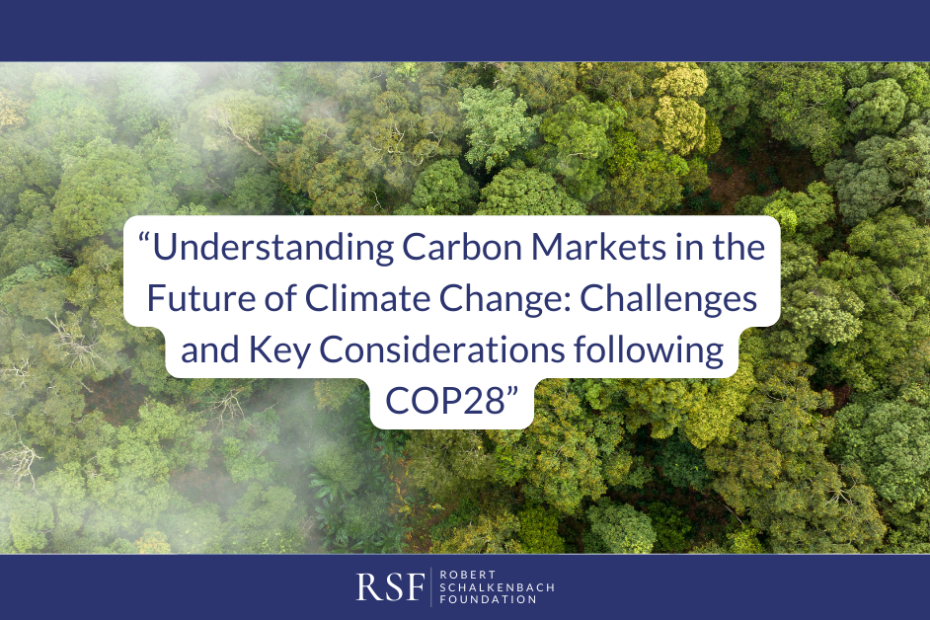In the fight against climate change, leaders at COP28 negotiated the creation of a global carbon market that could revolutionize climate economics. Following disagreements about key regulations in an international market, this blog will outline the basics of carbon markets, its challenges, and key considerations.
What are Carbon Markets?
There are two types of carbon markets: compliance and voluntary.
To encourage industries to reduce carbon emissions, some regulatory bodies enforce compliance carbon markets based on a cap-and-trade system where they issue carbon pollution permits. Regulatory bodies create a set number of permits to be distributed to companies in the system, and each permit allows a company to pollute a certain amount of carbon each year. Due to the permit cap, companies must buy and sell within the system.
Different markets have different regulations. For instance, the cap in the European Union’s Emissions Trading System (ETS) is reduced every year and permits become more expensive. This encourages companies to innovate and find ways to reduce emissions. The ETS is a compliance market and certain sectors (e.g., energy, aviation, etc.) are required to participate. There is no nationwide compliance market in the U.S., but California has a cap-and-trade program. Some private entities in the U.S. and worldwide participate in voluntary markets.
Voluntary markets, unlike compliance markets, face fewer regulations and rely on voluntary participation. They involve the exchange of carbon credits or offsets, where each credit represents one ton of greenhouse gas avoided (avoidance credit) or removed from the atmosphere (removal credit).
Carbon credits are issued by verification bodies and awarded to private entities and corporations who develop carbon projects involving carbon sequestration. Carbon credits are then sold to carbon emitting corporations, organizations, and individuals who wish to offset their own emissions.
Carbon sequestration
Carbon sequestration involves capturing carbon dioxide and securing it to prevent its release into the atmosphere. There are two major types: biological and geological.
Biological carbon sequestration occurs when carbon dioxide is stored in vegetation, soil or oceans. For instance, grasslands and soil naturally absorb carbon dioxide through photosynthesis and store it underground. Even if they are burned or cut down, the carbon remains in the roots and soil and would not enter the atmosphere.
Geological carbon sequestration is the process of storing carbon dioxide in underground rocks. Usually, carbon dioxide is captured industrially through steel and cement production, or through power plants and natural gas processing facilities. The carbon captured through those processes are then injected into porous rocks for long-term storage.
Compliance markets may accept carbon offsets from the voluntary market to help companies fulfill their carbon emission obligations, but each market has their own restrictions. For example, they may not accept credits from nuclear energy projects or afforestation projects. In 2020, the EU ETS stopped allowing the use of international credits awarded through carbon sequestration.
Regulatory and Structural Challenges
Compliance markets face several challenges in its execution. Fines for polluting beyond permitted amounts are often as low as 100 euros per excess ton and are hardly a deterrent. Regulatory bodies also face challenges in accurately measuring emissions, distinguishing between direct and indirect emissions, and detecting companies that exceed emission limits.
Furthermore, some countries enforce strict markets while others are lenient, leading to companies relocating to avoid paying for their emissions, also known as carbon leakage. Carbon border adjustment taxes deal with carbon leakage by imposing a tax on imported goods based on how much carbon was emitted to make them.
Voluntary markets face different problems, including fraudulent avoidance carbon credits. These projects falsely claim to offset carbon by preserving forests not at risk of deforestation. This contributes to greenwashing when corporations are allowed to claim that they offset their emissions by investing in avoidance credits. Other issues like double counting the amount of carbon credits available from a project or setting obscure and inconsistent prices for carbon credits raise integrity concerns.
Are Carbon Markets Profitable?
Carbon markets are highly profitable, as revenue from compliance markets and carbon taxes reached $95 billion in 2022. Revenue is often reinvested in carbon projects and renewable energy initiatives, or distributed through carbon dividends. For example, a portion of Switzerland’s carbon taxes are redistributed to their residents to subsidize the nation’s healthcare.
As profitability rises, countries should advance climate justice by investing in communities disproportionately impacted by climate change. Communities around the world are becoming more vulnerable to flooding, hurricanes, and droughts driven by climate change. Carbon market revenues should be used to provide infrastructure improvements to mitigate the effects and relief following extreme weather events.
While there is potential in carbon markets, they are far from perfect, and challenges highlight how difficult it can be to garner support from global leaders when creating a centralized market. Discussions at COP 28 highlighted similar issues relating to pricing, integrity, and carbon taxes, with the EU pushing for stricter rules and the US advocating for the opposite.

